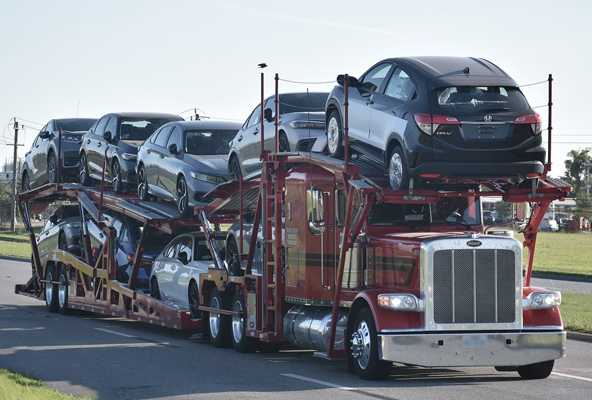Open Auto Transport
The most common form of car transport service is Open-Air. Approximately 97% of all car shipments are open transport, which is exposed to the elements such as dirt and weather. There is no overhead protection, nor side protection from the outside elements.
It is still relatively safe, as evidenced by all the new vehicles rolling down the highway nestled snugly in Open-Air Transport carriers. Car manufacturers know for certain that vehicles transported by Open-Air are highly unlikely to get damaged. The cheaper open auto transport cost combined with the low risk of physical damage makes Open-Air Transport the preferred method of car shipping to auto dealerships.
Open-Air Transport Service
There are several types of Open Air carriers, which run the gamut from a single car or two car trailers on a flatbed, all the way up to ten (10) car carriers on two tiers. In between, three (3) or four (4) car haulers are sometimes long flatbeds, but usually two-tiered trailers with two up and two down, which are usually used for shorter runs of 500 miles or less. It normally doesn’t make much economic sense to use a four-car hauler on a 1,000-mile or higher route. The mid-range auto transport routes of 500 miles to 1,000 miles are better suited to five (5) to seven (7) car haulers. But it is not unusual to see on the road, on those relatively shorter runs, the longer eight (8) to ten (10) car trailers as well. The more cars a transport carrier can haul, the more money to be made. But expenses also go up with hauling more cars. The 8-10 car trailers are almost always used for long-distance routes of 1,500 miles or more. Income and expense play a huge factor in that. Let’s do the math on a 2,000-mile route, such as Los Angeles to Chicago.
Why Customers Prefer Open-Air Transport
There are several types of Open Air carriers, which run the gamut from a single car or two car trailers on a flatbed, all the way up to ten (10) car carriers on two tiers. In between, three (3) or four (4) car haulers are sometimes long flatbeds, but usually two-tiered trailers with two up and two down, which are usually used for shorter runs of 500 miles or less. It normally doesn’t make much economic sense to use a four-car hauler on a 1,000-mile or higher route. The mid-range auto transport routes of 500 miles to 1,000 miles are better suited to five (5) to seven (7) car haulers. But it is not unusual to see on the road, on those relatively shorter runs, the longer eight (8) to ten (10) car trailers as well. The more cars a transport carrier can haul, the more money to be made. But expenses also go up with hauling more cars. The 8-10 car trailers are almost always used for long-distance routes of 1,500 miles or more. Income and expense play a huge factor in that. Let’s do the math on a 2,000-mile route, such as Los Angeles to Chicago.

Ready to transport your car with MCM Transport?
Our car shipping advisors are available by calling (857) 312 7749 to answer all your questions.
Request a quote